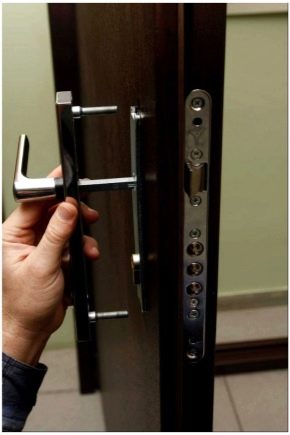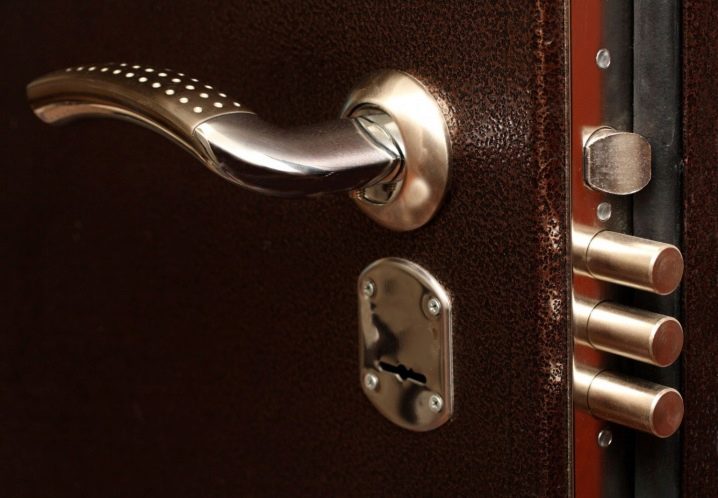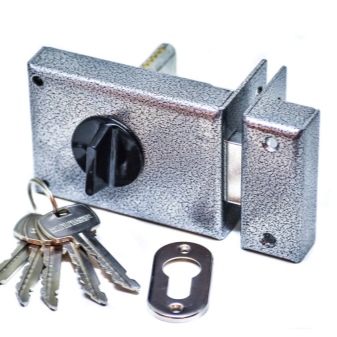DIY door lock repair

Locks perform a locking function and reliably protect housing from penetration of burglars. For various reasons, during operation, they can fail, requiring partial repair or replacement. To solve this unexpected problem, most of the owners of apartments and houses, preferring to save the family budget, carry out the installation and maintenance of parts on their own. Since this procedure is responsible and the safety of the home will depend on it in the future, the work must be done correctly.

Types of locks
Today the market is represented by a huge assortment of locks, each of which differs not only in external design, weight, material of manufacture, but also in the level of protection. Therefore, before you purchase such a product and be able to repair it yourself, you should know the characteristics of the devices. These types of locks are most often installed on the entrance doors.
- Hinged. They belong to the cheapest and easiest way to protect premises. They are usually installed on the entrance doors of cellars, outbuildings and small country houses. They are not suitable for country houses and city apartments, since they do not provide good security and do not have a high degree of secrecy.


- Mortise. These devices are the most common; they are mounted inside the door leaf. To install this product, you need to have certain skills, experience and special tools. The additional use of anti-burglary elements helps to increase the protective functions of mortise locks.


- Overhead. They are usually placed on the door inside the room, as for the protective mechanism, it is mounted directly inside the canvas. Such models are distinguished by a long service life and durability, since they have two modes of operation - automatic and mechanical. In the event of a malfunction, the patch lock can be easily repaired by yourself.


Depending on the design features of the internal mechanism, the following types of locks are distinguished.
- Cylinder. The doors open when the bolt is actuated by the turning movements of the key. The security element is located inside the cylinder and is a set of pins. Each bot needs its own key. Despite the fact that a combination of a million or more can be used to open such a model, the masters still advise complementing such devices with armor plates or lever mechanisms. These locks are easy to repair and are well suited for both entrance and interior doors.



- Suvaldnye. They are the most reliable locking product, which includes metal plates and code parts. In many ways, lever locks are similar to cylinder locks, but unlike the first ones, spring-loaded levers made of high quality steel are responsible for opening and closing the door. Outwardly, the device looks massive, has a significant weight and guarantees excellent protection. The larger the number of levers, the higher the security level of the castle.




- Pin. This type is recommended for installation on doors with a metal leaf. When the key is applied to the bolt, access to the room is blocked. Therefore, such a door lock cannot be opened without a key.In case of its breakdown, you will need to cut the crossbars placed between the frame and the door, and then replace the parts.



- Disk. They are versatile, as they can be installed on any type of door. The lock is unlocked by decoding the secret; for this, the discs must be set in motion with the key. In addition to their high durability, these mechanisms cannot be opened, even when trying to drill the larva, the discs will remain in place and rotate with the drill.



- Electromechanical. They belong to one of the modern types of locks, in which the action on the locking system is carried out using electrical impulses. After the mechanism receives a signal with the correct code, the door opens. In this case, a code combination, key fob or card serves as a key on the outside, and a button on the inside. The only drawback of this device is that in the event of a power failure, it stops working and turns off.



In addition to the above locking devices, there are also separate types that are intended for interior doors.
- Nobs. They are characterized by a special built-in locking system. The lock starts working when the handle is turned. Such models can consist of both a manual latch and a lock with a key. The main disadvantage of products is that they often break down, and the system can jam during long-term operation.
- Push types. Found wide application for installations in interior doors. Their package includes a latch tongue and a handle, when pressed, the mechanism retracts and the door opens. If you turn the handle to its previous position, then the latch takes its original place. In the event that the device breaks down, it can be repaired without much difficulty. In addition, this type of castle is inexpensive.
- Sockets. Such mechanisms are the most durable and reliable. They consist of a disc, a handle, a mounting hole and a locking system. With this lock, you can lock the door at any time and retire. The advantage of the device is also the fact that for its installation it is not necessary to cut a large hole in the door.
Based on the above, it is worth noting that recently it is not difficult to choose a suitable model of the castle. These can be locking devices of different designs, colors, as well as made in the form of a combination of metal with plastic, MDF and surface spraying. When making a purchase, it is recommended to pay attention not only to the attractiveness of the product, but also to its level of protection.

Common breakdowns
Sooner or later, when operating a door lock, you may encounter such an unexpected situation as its breakage. To answer the question of why the lock broke, you need to know the reason that caused it to fail. Most often, problems with the locking device are manifested in the following.
- The tongue stopped slamming. As a rule, this can be due to the insufficient diameter of the hole that was cut out for the mechanism. Cutting the hole and displacing the metal plate will help fix the breakage. In addition, skew or shrinkage of the door leaf can also cause blocking of the part. The tongue can also often wear out or loosen during long-term use.

- Complicated door opening. In this case, you should not immediately think about the breakdown of the locking device, since the malfunction may be caused by the skewing of the web itself. First, you need to adjust the door frame, and then adjust the location of the lock.

- The mechanism is jammed and the key does not turn. Such a nuisance is due to the displacement of individual moving elements inside the device. To find out everything exactly, you need to completely disassemble the lock, clean and lubricate the parts.

- Lock lock. Such a malfunction may lie in the larva.It should be replaced or repaired.

- Breakage of the outer case. Repair in this case is impossible, since the external part of the device will have to be replaced with a new one. If the case is out of order in the mortise lock, then you will need to dismantle all the parts of the device, thoroughly clean them and fix them in a new product.

- Turning the key. A breakdown in the system is caused by the failure of an auxiliary element, which is called a mating part. If the key inserted into the well does not move the bolt and is scrolled, then the counter plate must be changed. Such a procedure requires precise bore of the castle, only an experienced specialist can handle it.

Required tools
Regardless of whether it is planned to repair, replace or install a door lock, all tools should be prepared in advance. Of course, if the work will be performed by classified masters, then this will save you from unnecessary fuss. But in the case when the process is carried out independently, you will still have to prepare a minimum set consisting of the following tools.
- Manual router. It is used for inserting locks, since this tool provides high-quality cutting of recesses and accurate sampling. In addition, the freezer does not damage the decorative coating of the door leaf during operation.
- Hammer. It is most suitable for the non-professional sidebar, but it can come in handy sometimes.
- Chisels. Thanks to her, it will be possible to speed up the process of cutting a hole for a place for a lock.
- A screwdriver or drill. These tools are needed when drilling deeper seats and handle holes.
- Screwdrivers. For the working process, you will need both cross-shaped and flat screwdrivers of different diameters, with their help it will be possible to fix self-tapping screws and fasten the internal parts of the device.
- Drills for working with wood.
- Roulettes.
DIY repair
You can fix the lock on the door in an apartment or a private house on your own without the help of experienced craftsmen. To do this, you must have at hand the appropriate tools and basic skills in plumbing. It should be noted that before you repair the locking device, you should find out the cause of the breakdown and take into account the type of core, since basically this element of the mechanism is the main source of all problems. Lever and cylinder locks are usually installed on the entrance doors.

If the cylinder locks break, then first remove the armor plate, then dismantle the screw, which is located at the end of the door. Then you should pull out the cylinder itself and replace it with a new one. As for the lever devices, if they break, it is recommended not only to replace the larva, but also to repair the handles, since the latter can cause repeated malfunctions, then the tongue will begin to sink. It is much more difficult to cope with the repair of spacers on glass sheets and on a plastic balcony door. An unsuitable lock will need to be unscrewed, having previously removed the door from the hinges and disassembled the canvas.

In addition, the locks of the entrance and interior doors of a house or apartment should be periodically cleaned and lubricated. It is recommended to use machine oil for lubrication, and parts are cleaned as follows.
- At the first stage, the locking device is unscrewed, then all the elements of the mechanism are removed and carefully blown through. If a lot of dirt and dust particles have collected inside the castle, then the parts must be cleaned with a brush. Larger elements are wiped with a dry cloth.
- In the second stage, a lubricant is applied to a cotton swab and each part of the device is individually treated with it. Then they carry out the assembly and installation in the same place, checking the operation of the lock.

Quite often, locks in the interior door require prophylaxis. Under the influence of a large force load, the handle begins to jam, the tongue sinks or the locking latch dangles.Often, during the operation of interior doors, it is not the larva that fails, but the body itself. In this case, the malfunction can be eliminated with a screwdriver. First, dismantle the fasteners, then carefully remove the mechanism box. The repair ends with the installation of a new case and its fixation. Such work is only suitable for surface-mounted and padlocked locks. The situation is different with mortise devices:
- first of all, unscrew the screws;
- then they dismantle all the parts and remove the lock from the seat;
- the box is placed on a flat surface and the screws are removed;
- the damaged body is removed, replacing it with a new one, and the box is again mounted in the door pocket.

It is worth paying attention to the fact that interior doors are most often equipped with a handle-lock, therefore, it is its breakdown that causes the failure of the entire locking device. As a rule, the handle can break when it becomes covered with rust, when the mechanism is dusty, or due to distortions and deformation of the door leaf. Therefore, if the latch is simply ignited in the lock, then the spring located in the rear wall is replaced. A loose handle should simply be returned to its original position by twisting the fasteners. If the latching elements jam, you will need to check them for cracks, deformation and displacement. If there are any, then you need to replace the damaged part with a new one.

As for magnetic locks, their repair is quite simple. Since there is a natural magnet in these devices, which can lose its attraction property over time, it is replaced or remagnetized. In addition, you need to periodically check the tightness of the lock to the door, since the slightest deviations can weaken the operation of the mechanism.

Only professionals can eliminate the malfunction of electromagnetic locks, since it is difficult for inexperienced craftsmen to open the entrance group. This device is controlled by an electronic unit, therefore it is he who is considered a frequent cause of breakdown. Repair in this case can include both the replacement of electrical wiring and modules with boards. Therefore, if such a lock does not work, first of all it is necessary to make sure whether the system is connected to the electrical network, whether there are any faults in the wiring, whether electricity is supplied by voltage. The power supply can fail, it will have to be replaced with a new one.

Despite the fact that the repair of door locks will seem simple, before you start doing it yourself, you need to really assess your capabilities, since many types of locks have a complex design, and do-it-yourself repairs can harm them. In addition, in order to provide reliable protection for housing, experts recommend installing several different types of locking devices at the same time. Thus, if one of them fails, the house or apartment will be safe until repair work is carried out.
Advice
Today, everyone can try themselves in the role of a master and carry out repairs or installation of door locks on their own. This allows not only to significantly save the family budget, but also to gain a good experience. In order for the workflow to go through quickly and correctly, beginners should consider the following recommendations.
- If the lock breaks, you should not immediately disassemble the case, first you need to make sure that there are no foreign objects and debris in the lock hole. If there are any, then it is necessary to remove the foreign bodies with an awl or tweezers.
- In the event that the key is stuck or broken, do not panic. First you need to remove it, then proceed with the repair. If the attempt fails, then it is best to invite a master.
- If the latch and the bolt are jammed, it is enough to do with the sash adjustment.In addition, you can additionally check the position of the awnings and door leaf for deflection and deformation. To eliminate such a problem, you just need to expand the key hole by a few millimeters, then the latch and bolt will freely enter.
- To eliminate malfunctions in the protective mechanism that cause jamming, you should completely disassemble the device and check if all the elements are in place, if there are worn parts. Replacing the core can be the most difficult in case of a breakdown.

How to repair the castle with your own hands, see the video.













The comment was sent successfully.